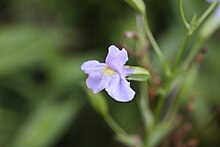Mimulus ringens
This article includes a list of general references, but it remains largely unverified because it lacks sufficient corresponding inline citations. (February 2015) |
| Mimulus ringens | |
|---|---|

| |
| Scientific classification | |
| Kingdom: | Plantae |
| Clade: | Tracheophytes |
| Clade: | Angiosperms |
| Clade: | Eudicots |
| Clade: | Asterids |
| Order: | Lamiales |
| Family: | Phrymaceae |
| Genus: | Mimulus |
| Species: | M. ringens
|
| Binomial name | |
| Mimulus ringens | |
Mimulus ringens is a species of monkeyflower known by the common names Allegheny monkeyflower and square-stemmed monkeyflower.
It is native to eastern and central North America, and there are occurrences in the western United States, some of which may represent introductions. It grows in a wide variety of wet habitat types. Seeds are available from commercial suppliers.
This is rhizomatous perennial growing 20 centimeters to well over a meter tall, its 4-angled stem usually erect. The oppositely arranged leaves are lance-shaped to oblong, up to 8 centimeters long, and sometimes joined or nearly so clasping the stem. The herbage is hairless. The flower 2 to 3 centimeters long, its tubular base encapsulated in a ribbed calyx of sepals with pointed lobes. The flower is lavender in color and divided into an upper lip and a larger, swollen lower lip.
One variety of this plant, var. colophilus, is rare, ecologically restricted, and vulnerable. It is known from Quebec, it has been reported in Vermont, and there are a few occurrences in Maine, where it grows only in freshwater sections of tidal estuaries.[1] This plant variety faces several threats, but its current status is not known due to a lack of data.[1]
References[]
External links[]
| Wikimedia Commons has media related to Mimulus ringens. |
- Mimulus
- Flora of the Northeastern United States
- Flora of the United States
- Plants described in 1753
- Taxa named by Carl Linnaeus
- Flora of the Southeastern United States
- Flora of the Great Lakes region (North America)
- Flora of Canada